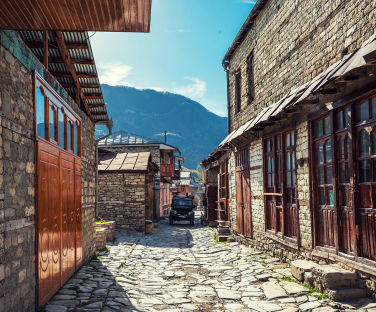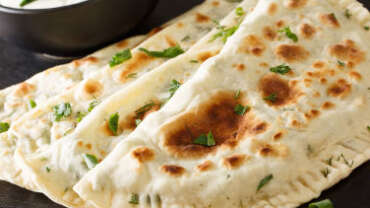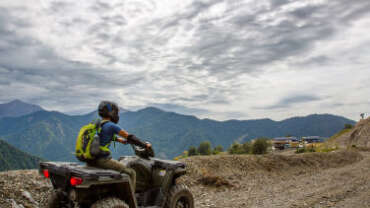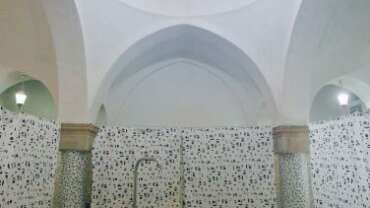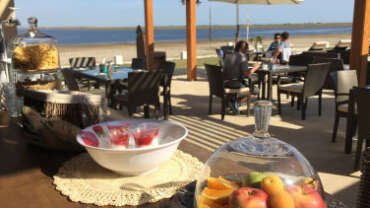Museums & Galleries
Baku’s Old City
Baku’s medieval core is a UNESCO-protected site surrounded by 12th-century walls, brimming with history and Eastern architecture. Here you’ll find the Maiden Tower, Baku’s most mysterious site – no one knows for certain what it was originally built for! Meanwhile, occupying the highest spot in the citadel, the Shirvanshahs’ Palace was the 15th-century residence of Azerbaijan’s medieval rulers. Beyond its main attractions, the ‘Inner City,’ as it’s called by the locals, is a labyrinth of narrow alleyways home to some of Baku’s oldest residents, as well as artists’ workshops, souvenir stalls and traditional restaurants serving classic Azerbaijani dishes.
Discover the legacy of ancient fire worshippers
Baku’s extraordinary landscape, rich in oil and subterranean gases, has intrigued travellers since time immemorial and for centuries the Ateshgah Fire Temple in the village of Surakhani has been attracting crowds of thrill seekers. Built in the 17th–18th centuries around naturally burning flames which were previously worshipped by Zoroastrians, the site was then an important place of pilgrimage for fire-worshipping Hindus until the 1880s. Today it houses a well-designed museum and is often coupled with a trip to nearby Yanardag, the Burning Mountain in Mammadli village where a 10-metre wall of flames blazes day and night at the base of a hillside. These natural flames were described by Marco Polo in the 13th century and continue to mesmerise those who visit the site. Today you can learn all about them at the beautifully arranged new museum complex.
Discover Gobustan’s ancient rock art
From prehistoric rock art to musical stones, the Azerbaijani people’s age-old past is dramatically brought to life in the UNESCO-listed Gobustan Reserve, where an astonishing collection of over 6,000 ancient petroglyphs chart ways of life dating back as far as 40,000 years. The reserve is located among the Boyukdash, Kichikdash and Jingirdagh mountains, about 60 kilometres south of Baku, and is also home to the remains of once inhabited caves, settlements and burial grounds, all reflecting intensive human use from the Upper Palaeolithic to the Middle Ages. What’s more, just a short drive away you’ll find some of Azerbaijan’s astonishing number of mud volcanoes, one of the world’s most intriguing natural wonders.
Soak up the history of old Gabala
History enthusiasts shouldn’t miss calling into the village of Chukhur Gabala, 15 kilometres south-west of Gabala, to discover the ruins of the ancient city of Gabala – a major trade and social hub along the Silk Road between about 4BC and 18AD and once the capital of the ancient state of Caucasian Albania. The site has been researched by archaeologists since 1929, revealing many historical treasures including a medieval water supply system, coins and ceramics, burial sites and the remnants of buildings harking back to diverse historical eras. The highlight, though, are two round brick towers and parts of a fortress wall that once formed the city’s southern entrance. After exploring the 25-hectare site’s excavation areas by car and on foot, browse the nearby contemporary museum which tells you all you need to know about the area’s history.
Visit Baku’s Carpet Museum
The Carpet Museum, situated on the Seaside Boulevard, is another of Baku’s modern architectural wonders – it’s shaped like a rolled-up rug! And inside it’s home to the largest collection of Azerbaijani carpets in the world (over 6,000!). There’s simply no better place to begin your journey into the world of Azerbaijani carpet weaving. Strolling around the exquisitely curated exhibits, you’ll discover how our carpets are made through live demonstrations, how they have evolved throughout the centuries and you’ll also be able to compare and contrast hundreds of stunning examples from across our seven regional carpet weaving schools.
Visit the first museum of Mountain Jews
Located opposite Guba city on the northern banks of the Gudiyalchay river, Red Settlement (also known as Girmizi Gasaba or Krasnaya Sloboda) is a truly unique place to visit. Characterised by its red-tiled roofs, this village is thought to have once been the only entirely Jewish settlement outside of Israel and the United States and the world’s last surviving shtetl. Its residents are Mountain Jews whose ancestors have been living in the Guba region for centuries. Founded in the mid-18th century, the village thrived under the protection of the ruling Guba khan, becoming a diverse yet closed community of Mountain Jews. And in the centuries since it has survived plenty of upheavals, maintaining its own culture and traditions, as well as the unique Juhuri language. A landmark new museum opened here in 2019.
Discover traces of Caucasian Albania near Sheki
Just five kilometres from Sheki, travel to the picturesque village of Kish to explore Albanian temple, one of our greatest monuments of Caucasian Albania – an ancient state that existed here from about 3BC to 8AD. The core of this beautiful church is thought to date to 1AD, yet archaeologists have discovered evidence that a cultic site existed here as early as 3,000BC! The church now functions primarily as a museum to Caucasian Albania and features a host of Bronze Age ceramics discovered during excavations carried out in the early 2000s by a joint Azerbaijani-Norwegian team, as well as glass-covered vaults displaying ancient graves with two-metre long skeletons.
UNESCO WORLD HERITAGE SITES
Experience the Silk Road in Sheki
Take a break from an itinerary packed with sightseeing and spend a morning or afternoon simply wandering the cobbled streets of Sheki’s historic old town, an area that was recently added to UNESCO’s World Heritage List. Soak up the bucolic atmosphere, admire the intricate brickwork and hunt for some historical relics. This upper part of the city is made up of 19th-century merchant housing with distinctive gabled roofs, mosques and hammams, reflecting Sheki’s long history as a former hub of the silk trade. You can visit house museums to local literary heroes Mirza Fatali Akhundzade and Bakhtiyar Vahabzade and call into the Sheki Khans’ House. For a Quintessential Silk Road experience in Sheki, stop for tea and sweets or better still spend a night at Karvansaray, an authentic 18th-century caravanserai-turned-hotel.
Take a tour of Sheki Khan’s palace
Resting in the shade of 500-year-old plane trees at the top of Sheki, the lavishly decorated Palace of Sheki Khans is our most exquisite architectural monument of the khanate period. It was built in the late 18th century as the ruling Sheki Khan’s summer residence in the cool foothills of the Caucasus Mountains. The local rulers clearly had an eye for detail: the palace is laden with intricate details both inside and out, from sprawling frescoes to geometrically patterned tiles. The palace’s windows are also the best place to see one of Sheki’s signature crafts – shebeke, a technique of filling wooden lattices with thousands of pieces of coloured glass fitted together without glue or nails. Take a tour with one of the knowledgeable onsite guides who will help bring the place to life.
Carpet weaving in Guba
Along with its beautiful nature and magnificent mountains, Guba is an ancient city with colourful traditions. People here have been weaving carpets since time immemorial, which you can learn about from local weavers at several carpet factories open to curious visitors. Over 30 types of carpet are woven, traditionally by women, in villages such as Pirebedil, Devechi, Gonagkend, Zeiwa and Garagashli, as well as the neighbouring region of Gusar.
What’s more, each village’s carpets have their own characteristics, for example carpets woven in Pirebedil are famous for their elaborate floral designs on blue or ivory backgrounds, while those woven in Gonagkend often have a central medallion, and those called ‘Butali’ usually feature buta elements, representing fire. One great way to experience these age-old traditions is by booking a masterclass through private guides or the Guba Destination Management Organisation.
Take a day trip to Lahij
About three hours’ drive from Baku via a geologically spectacular canyon, the pretty little village of Lahij woos visitors with its antique cobbled streets, stone houses, souvenir shops and crafts. In the past over 40 different crafts were practised in this historic village, which is now a historical and cultural reserve and whose inhabitants converse in their own language. They included hat making, leather production and carpet weaving. However, Lahij is most famous for its unique copperwares, which in the past were sold all across the Caucasus and the Near East. It was always thought that the best coppersmiths hailed from Lahij. The cool mountain air makes travelling here especially appealing in summer, which is also a great time to try some of the many hikes (offered by Baku-based tour companies) that start or end in or around this timeless village.
Visit German-inspired Goygol
Ten kilometres south of Ganja, the story of Azerbaijan’s German colonists began in 1819 with the founding of a village called Helenendorf (now Goygol). Besides becoming a hub of German culture in the Caucasus, Helenendorf was also famous for its burgeoning wine industry that sold wine and spirits throughout the Russian Empire. The Germans may have gone – they were deported by Stalin in 1941 – but the Goygol Winery still functions and their presence continues to be felt in the town’s old German streets lined by towering plane trees. Over 300 distinctly German houses remain, one of which is the Victor Klein House, the former residence of Goygol’s last German and now a museum. Nearby is Azerbaijan’s first Lutheran church which was built in 1854 and today also houses a small museum collection. All the main sights can be discovered with the help of interactive info boards.
Visit Shamkir’s German heritage
Modern Shamkir began life as the German colony of Annenfeld which was founded in 1819 and went on to become a hotbed of winemaking in Azerbaijan. The Germans were tragically deported from here in 1941 but today the city centre has kept a uniquely Germanic feel – think long straight streets with original German country housing, a Lutheran church dating back to 1909, and a German park with café, paths and benches. What’s more, the centrally located Excelsior hotel serves authentic craft beer homebrewed according to a German recipe.
Visit Ganja’s Imamzadeh Mausoleum
Located roughly 7 km north of Ganja is one of Azerbaijan’s most important religious sites. The Imamzadeh Mausoleum (also known as the Goy dome, the Goy Mosque or the Goy Imam) was built in various stages beginning from the 14th century around the grave of one of the sons of the 5th Shiite Imam, Muhammed al-Baqir. Over the years the grave developed into a mausoleum and then a complex. A series of mosques and caravanserais surrounded by fortress walls appeared and disappeared until between 2010 and 2016 the complex was completely restored. Look out especially for the mausoleum’s exquisite blue-tiled dome, decorated with peacocks and floral patterns.
Stroll through the Khan’s Park & around
Spend half a day strolling the city centre, home to Ganja’s main historical attractions. On the central square, browse the Shah Abbas Mosque complex and medieval baths, built during the Safavid dynasty that governed Azerbaijan for over 200 years. Discover the nearby mausoleum to Javad Khan, the last khan of Ganja, following whose death Ganja became part of the Russian Empire and then the Soviet Union. Traces of that are clearly visible in several more buildings around the square: the grand city hall exudes Socialist Classicism, while the Ganja Hotel and Academy of Sciences opposite are grand, imposing and Stalinist. From the square head south-west to the Khan’s Garden, a six-hectare urban oasis that’s one of Azerbaijan’s oldest parks, and don’t miss the nearby Agricultural University building, which briefly housed the government of Azerbaijan’s first independent republic in 1918.



